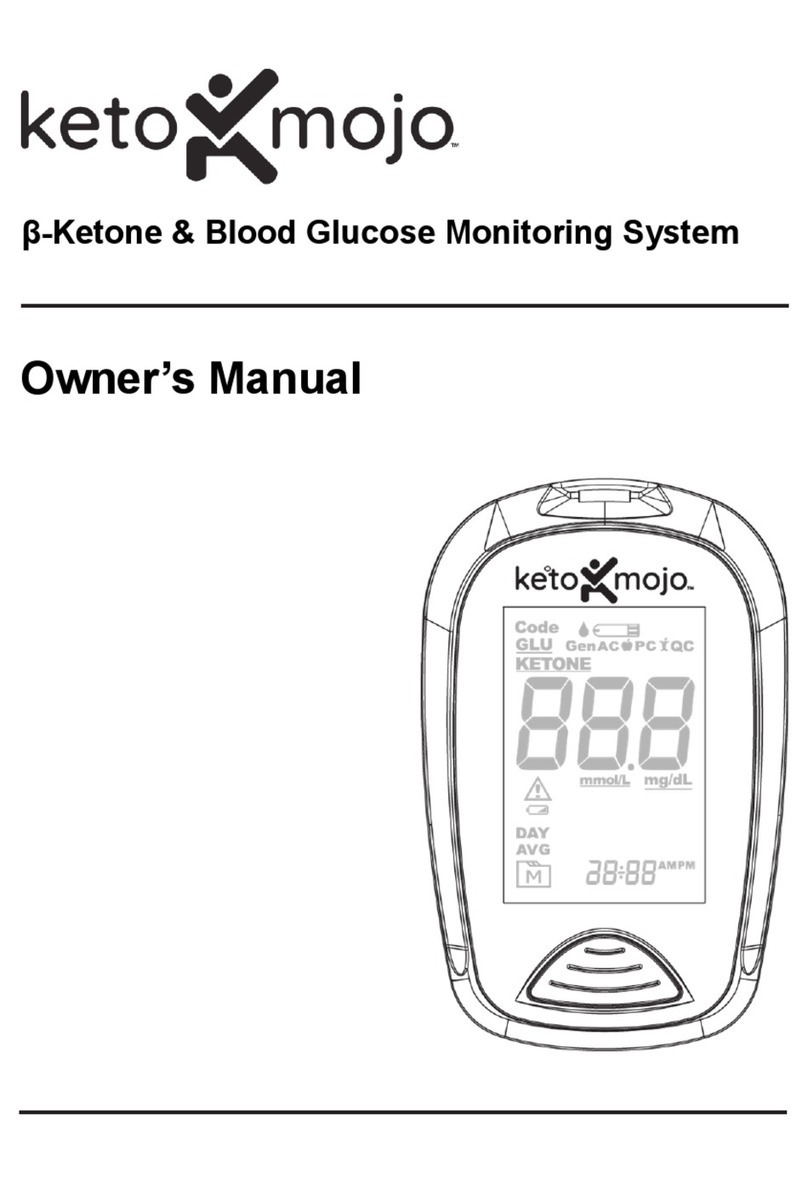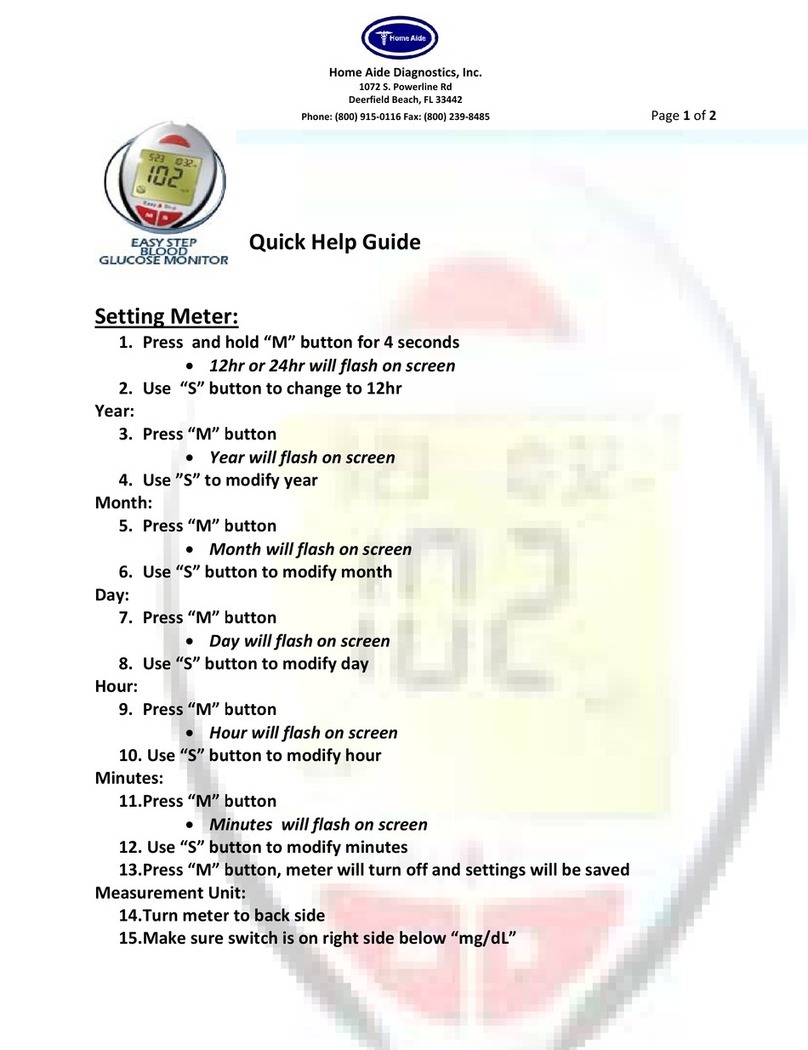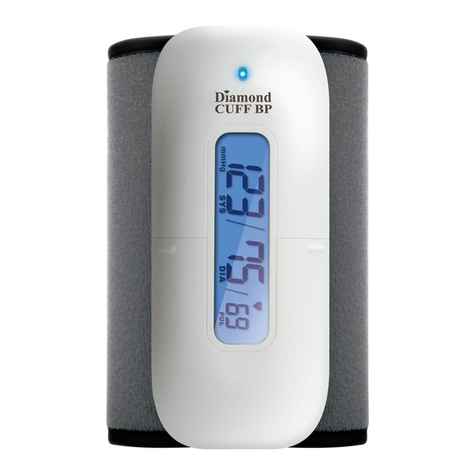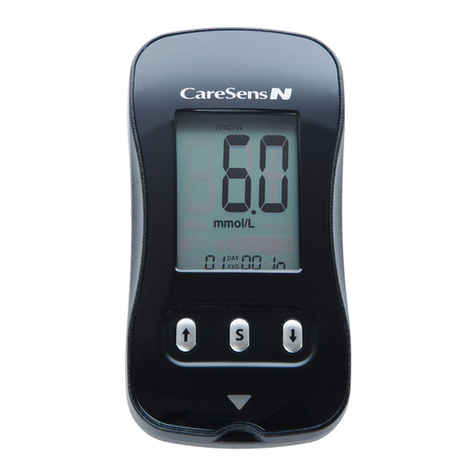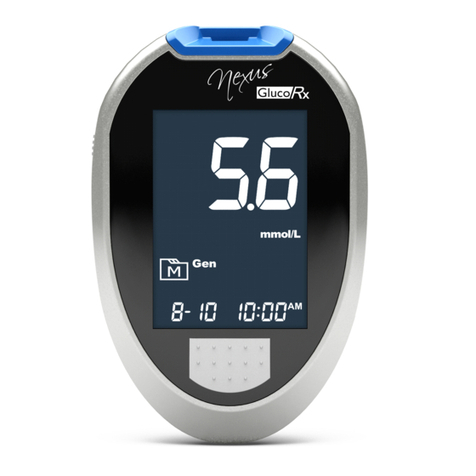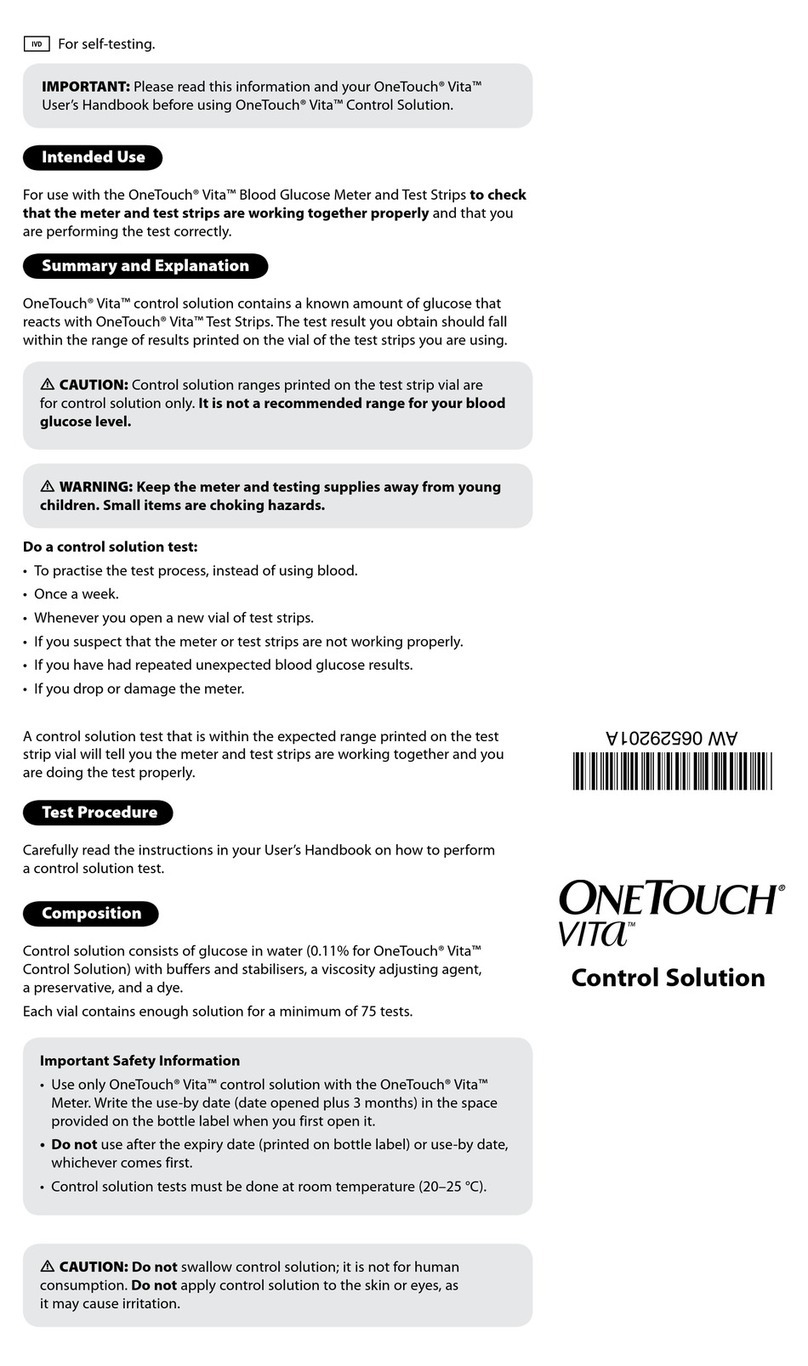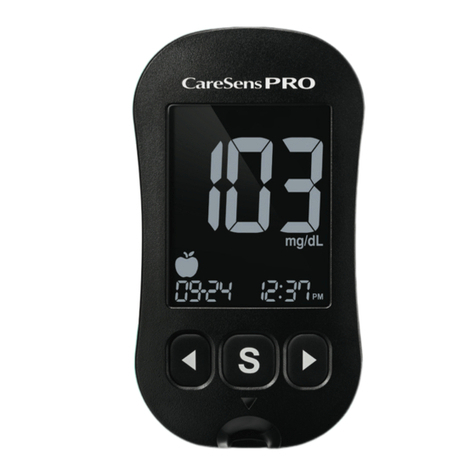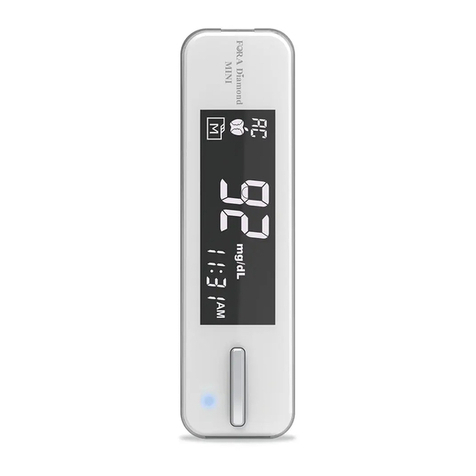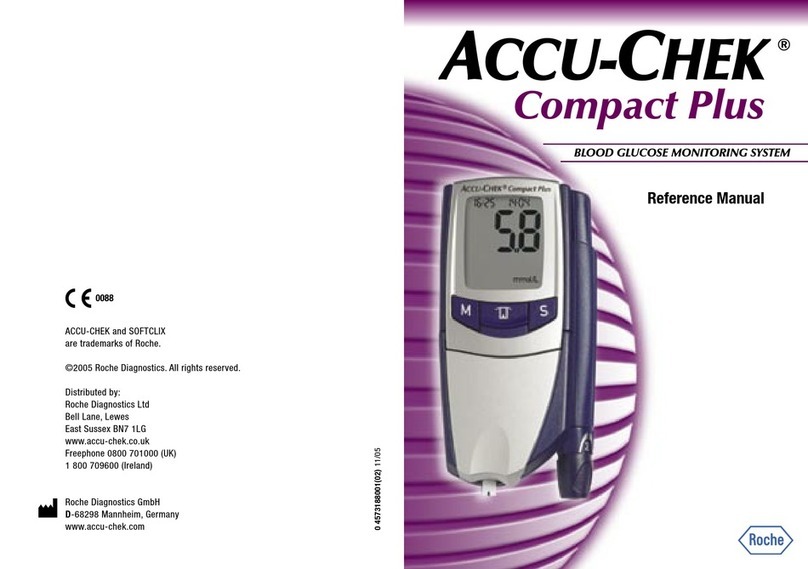Keto-Mojo GKI User manual

i
Multi-function Monitoring System
Dear Keto-MojoTM GKI System User,
Thank you for choosing the Keto-MojoTM GKI System! Keto-MojoTM GKI System
is designed for easy test of blood Glucose/blood Ketone and helps you keep them
under control.
Read this User’s Manual carefully before you use your meter system. Please keep
your User’s Manual in a safe place; you may want to refer it in the future.
Thank you again for choosing the Keto-MojoTM GKI System.
Principle and Intended Use
The Keto-MojoTM GKI Multi-function Monitoring System is designed to
quantitatively measure the blood Glucose concentration in fresh
capillary/venous/arterial/neonatal whole blood, and the blood Ketone concentration
in fresh capillary whole blood. The Keto-MojoTM GKI Multi-function Monitoring
System is based on measurement of electrical current caused by the reaction of
the Glucose/Ketone with the reagents on the electrode of the test strip. The blood
sample is pulled into the tip of the test strip through capillary action.
Glucose/Ketone in the sample reacts with the enzyme and the mediator. Electrons
are generated, producing a current that is positive correlation to the
Glucose/Ketone concentration in the sample. After the reaction time, the
Glucose/Ketone concentration in the sample is displayed. The meter is calibrated
to display plasma calibrated results.
The Keto-MojoTM GKI Multi-function Monitoring System is intended for use outside
the body (in vitro diagnostic use) by people at home and healthcare professionals
in clinical setting, as an aid to monitor the effectiveness of diabetes control. The
system should not be used for diagnosis of diabetes. Professionals may also test
neonatal, venous and arterial blood samples.

ii
TABLE OF CONTENTS
1. Understanding Your Testing Tools……………………………………..
1
Your Meter System Overview……………………………………………...
1
Your Meter Display………………………………………………………….
2
Important Safety Information………………………………………………
4
2. Setting Up Your System…………………………………………………..
5
Set the Date and Time……………………………………………………...
5
Set the audio feature………..……………………………………………...
6
Set the Test Alarm…………..……………………………………………...
7
Set the Meal Marker………...……………………………………………...
8
Set the Hypoglycemia(Hypo)Alarm…………………………………….
8
Set the Ketone Warning……..……………………………………………..
8
Pairing Your Meter with the Smart Phone
9
3. Performing a test………………………………………………………......
10
Preparing the Test Strip…………………………………………………….
10
Preparing the Lancing Device……………………………………………..
10
Getting a Blood Drop and Testing…………………………………………
11
Alternative Site Testing.………………………………………..…………..
14
GKI testing
16
Testing with Control Solution…………………………….……………......
20
Using the Meter Memory…………………………………………………..
22
4. Maintenance and Troubleshooting……………………………….........
24
Replace Batteries…………………………………………………………
24
Caring for Your Keto-MojoTM GKI Multi-function Monitoring System….
25
Troubleshooting Guide……………………………………………………..
25
5. Technical Information……………………………………………………..
27
System Specifications……………………………………………………...
27
Limitations…………………………………………………………………...
28
Warranty……………………………………………………………………..
28
Index of Symbols……………………………………………………………
29

1
CHAPTER 1: UNDERSTANDING YOUR TESTING TOOLS
Your Meter System Overview
The Keto-MojoTM GKI Multi-function Meter and Test Strips

2
Your Meter Display
The picture below shows all the symbols that appear on your meter display. To
make sure the display is working properly. All of the segments should be clear and
exactly like the picture below. If not, contact Keto-Mojo for further assistance.
Icon
What it Means
Top left area on the screen indicates date.
Top right area on the screen indicates year or time.
Date, month.
Indicates successful Bluetooth communication
Indicates failed Bluetooth communication
Indicates the alarms have been set.
Blood Glucose test mode.
GKI
Glucose Ketone Index and GKI test mode.
Blood Ketone test mode.
Indicates average value.
Indicates low battery or battery needs to be replaced.
Indicates test result history.
Center area on the display that shows test results or error codes.
Indicates the system is ready to test.
Ketone warning.
Indicates that a low Glucose test result may cause hypoglycemia.
Pre-meal marker.

3
Post-meal marker.
Control test result.
Test results are displayed as mg/dL or mmol/L according to local
government regulation.
Indicates the temperature is not suitable for testing.
Notes:
Your Keto-MojoTM GKI Multi-function Meter is pre-set with beep sound function,
the meter will beep when:
•You turn on the meter.
•While setting the test type.
•When setting the date and time.
•When the test strip is inserted and is ready for application of blood or control
solution.
•When sufficient blood or control solution is pulled into the test strip.
•When the test is complete.
•If any error occurs during operation.
Meter Use and Precautions
•The meter is pre-set to display blood Glucose/Ketone concentration in either
millimoles per liter (mmol/L) or milligrams per deciliter (mg/dL) depending on
which unit of measure is standard in your country. And meter is pre-set to
display blood Ketone concentration in millimoles per liter (mmol/L). The unit of
measure cannot be adjusted.
•Do not get water or other liquids inside the meter.
•Keep the strip port area clean.
•Keep your meter dry and avoid exposing it to extremes in temperature or
humidity. Do not leave it in your car.
•Do not drop the meter or get it wet. If you do drop the meter or get it wet, check
the meter by running a quality control test. Refer to Quality Control Test for
instructions.
•Do not take the meter apart. Taking the meter apart will void the warranty.
•Refer to the Caring for Your Meter section for details on cleaning the meter.
•Keep the meter and all associated parts out of reach of children.
Note: Follow proper precautions and all local regulations when disposing of the
meter and used batteries.
All Glucose systems preventive warnings with regard to EMC
1. This instrument is tested for immunity to electrostatic discharge as specified in
IEC 61000-4-2. However, use of this instrument in a dry environment,
especially if synthetic materials are present (synthetic clothing, carpets, etc.)
may cause damaging static discharges that may cause erroneous results.
2. This instrument complies with the emission and immunity requirements
described in EN61326-1 and EN61326-2-6.Do not use this instrument in close

4
proximity to sources of strong electromagnetic radiation. It may interfere with
proper operation of the meter.
3. For professional use, the electromagnetic environment should be evaluated
prior to operation of this device.
Important Safety Information
•Do not use the meter if it is dropped into water or water splashes on it.
•Test strips and lancets are for single use only.
•Do not drop blood on the flat surface of the test strip.
•Check the expiration dates and discard dates on your test strips foil pouch / kit
box and control solution bottle label.
•Use only Keto-MojoTM Blood Glucose/Blood Ketone Test Strip with your
Keto-MojoTM GKI Multi-function Meter.
•Use only Keto-MojoTM Blood Glucose/Blood Ketone Control Solution with your
Keto-MojoTM GKI Multi-function Meter.
Potential Biohazard
Healthcare professionals or persons using this system on multiple patients
should follow the infection control procedure approved by their facility. All
products or objects, which come in contact with human blood, even after
cleaning, should be handled as if capable of transmitting viral disease

5
CHAPTER 2: SETTING UP YOUR SYSTEM
Before using your meter for the first time or if you change your meter battery, you
should check and update your meter settings.
Set the Date and Time
1. Enter the setting mode and set the clock
When the meter is off, press and hold the power button for more than 2 seconds
until the meter beeps to enter the set up mode. Press the button on the left side of
the meter to adjust and set the clock for 12 or 24 hour mode, then press the power
button to save your choice. Now you can proceed to set the date.
2. Set the date
The year position will now flash on the display. Press the button on the left side of
the meter to adjust it until the year setting is completed, then press the power
button until the meter beeps to set.
The month will now flash, press the side button to adjust the month. Press the
power button until the meter beeps to set.
The date will now flash, press the side button to adjust the date until the date
setting is completed, then press the power button until the meter beeps to set.

6
3. Set the time
After the date setting is completed, press the power button until the meter beeps to
set, the hour will now flash. Press the side button to adjust the current hour until the
hour setting is completed, then press the power button until the meter beeps to set.
The minute will now flash, press the side button to adjust the minute until the
minute setting is completed.
Note:
Before your first use of the meter for testing, please adjust the meter settings to set
the correct date and time, ensuring that results stored in the memory are shown
with the correct date and time.
Set the audio feature
After setting the time, press the power button until the meter beeps to set, the beep
will now flash. Press the side button to set ON or OFF, press the power button to
save the audio setting.

7
Set the Test Alarm
After the audio setting is completed, the meter will enter the test alarm setting
mode, the reminder function reminds users to take a measurement. You can set up
to 5 reminders per day. If you turn 5 test alarms on (A1, A2, A3, A4 and A5), your
meter is pre-set with the following times for your convenience, you can adjust each
time to suit your needs.
A1 7:00 A2 9:00 A3 14:00 A4 18:00 A5 22:00
Before you set the time, the and the word “OFF” will be displayed, symbol “A1”
flashes. Press side button to turn the alarm function on or off, and press power
button to save.
If you select “On”, the hour flashes, “A1” and the will remain on the display.
Press side button to select the hour. Press power button to set.
The minute flashes, press side button to select 00, 15, 30, or 45. These are the
only choices, press power button to set.
The next alarm “A2” flashes on the display with “OFF”.

8
You can either set a second alarm by pressing side button to turn on the second
alarm. Do the same procedures to set the rest alarms.
Note: If the meter is on at the test reminder time, the test alarm will not get
activated.
Set the Meal Marker
After setting the test alarm functions, the symbols of will now flash, along
with word “On” on the display. Press the side button to turn the meal marker
function on or off, press power button to set
Set the Hypoglycemia (Hypo) Warning
After setting the meal marker, you can set the hypo alarm, which indicates a
possible hypoglycemic condition (blood sugar level too low).
After you have confirmed the selection of setting test alarm, the flashes on
the display along with “On” on the display. Press side button to turning the Hypo
alarm function on or off, press power button to set. If you select the hypo alarm “on”,
the display shows 70 mg/dL with the symbol of “GLU”on the display, press power
button to set.
Notes:
•Talk to your healthcare professional to help you decide the hypo level that suit
for health condition.
•For healthcare professionals, the hypoglycemic level may vary from person to
person. It is recommended to turn the hypo alarm function OFF when using the
meter in a professional facility.
Set the Ketone Warning
After the hypo warning setting is completed, the symbol now will flash,
along with word “On” on the display. Press side button to turn the Ketone Warning
on or off, press power button to set.

9
If you turn Ketone Warning on, the symbol will appear with the other
symbols that you have set before.
After setting Ketone Warning, the screen will show all symbols which you have set
before. Press power button and the meter will be turned off.
Once all the settings are completed, if you want to change the setting, please press
and hold the power button when the meter is powered off and then return to the
setting mode.
Pairing Your Meter with the Smart Phone
Pairing prepares your Keto-MojoTM GKI Multi-function Meter and Smart Phone to
communicate with each other. The distance between the meter and Smart Phone
should be within 5 meters. Download the Keto-MojoTM App before pairing your
meter and Smart Phone.
Note: Keto-MojoTM App is compatible with Android software version 4.1 and
above and ios version 8.0 and above.
WARNING
Do Not pair another person’s meter with your Smart Phone.
To pair the Smart Phone with your meter, start with your meter turned on and follow
these steps:
1. Turn your meter on.
2. Turn on Bluetooth? on your Smart Phone.
3. Look for a device named Keto-MojoTM GKI Meter. This is your meter.
4. Tap on the entry that represents your Keto-MojoTM GKI Multi-function meter.
5. Enter your meter pass code using the keypad. The pass code is the last 5 digits
from the Serial Number on the back of your meter.
6. Tap Pair.

10
CHAPTER 3: PERFORMING A TEST
Set up your meter correctly and have all the materials you will need ready before
you begin testing. This includes your Keto-MojoTM GKI Multi-function Meter,
Keto-MojoTM Blood Glucose test strips, Keto-MojoTM Blood Ketone test strips, and
Keto-MojoTM lancing device and lancets.
Preparing the Test Strip
1. Wash and dry your hands well before testing.
2. Remove a test strip from the test strip foil pouch.
3. Insert the test strip into the meter in the direction of the arrows.
4. A symbol with a test strip with a flashing blood ( ) will appear letting
you know the meter is ready to test.
Note:
Check the expiration and discard dates on the test strip foil pouch. All expiration
dates are printed in Year-Month format. 2021-01 indicates January, 2021. Make
sure the test strip does not appear damaged. Prior to testing, wipe and dry the test
site with an alcohol swab or soapy water. Make sure there is no cream or lotion on
the test site.
Preparing the Lancing Device
For fingertip sampling, adjust the depth penetration to reduce the discomfort. You
do not need the clear cap for fingertip sampling.
1. Unscrew the lancing device cover from the body of the lancing device. Insert
a sterile lancet into the Lancing Device and push it until the lancet comes to a
complete stop in the lancing device.
Note: The Keto-MojoTM lancing device uses ONLY Keto-MojoTM sterile lancet.

11
2. Hold the lancet firmly in the lancing device and twist the safety tab of the
lancet until it loosens, then pull the safety tab off the lancet. Save the safety
tab for disposing used lancet.
3. Carefully screw the cover back onto the lancing device. Avoid contact with
the exposed needle. Make sure the cover is fully sealed on the lancing
device.
4. Adjust the puncture depth by rotating the lancing device cover. There are
several different puncture depth settings. To reduce the discomfort, use the
lowest setting that still produces an adequate drop of blood.
Adjustment:
1for delicate skin
2 and 3 for normal skin
4 and 5 for calloused or thick skin
Note: Greater pressure of the lancing device against the puncture site will also
increase the puncture depth.
Getting a Blood Drop for Testing
1. Pull the cocking barrel back to set the lancing device. You may hear a click to
indicate the lancing device is now loaded and ready for obtaining a drop of blood.

12
2. Press the lancing device against the side of the finger to be lanced with the
cover resting on the finger. Push the release button to prick your fingertip. You
should hear a click as the lancing device activates.
3. Gently massage from the base of the finger to the tip of the finger to obtain
the required blood volume. Avoid smearing the drop of blood. For the
greatest reduction in pain, lance on the side of the fingertips. Test
immediately after a good blood drop has formed.
4. Immediately touch the tip of the test strip to the drop of blood. The blood will
get pulled into the test strip through the tip. Make sure that the blood sample
has fully filled the check window of the tip of the strip. Hold the tip of the test
strip in the blood drop until the meter beeps.
Note:
If the blood sample does not fill the check window, do not add a second drop.
Discard the test strip and start over with a new test strip.
5. For Glucose testing, the meter counts down from 5 to 1, and for Ketone
testing, the meter counts down from 9 to 1. And then the result appears on
the display. The test result will automatically be stored in the meter memory.
Please do not touch the test strip during the countdown as this may result in
an error.

13
Discard the Used Test Strip
You can eject and discard the used test strip by using the strip ejector. Meter turns
off automatically after a beep.
Potential Biohazard
Dispose of the used test strips as medical waste.
Questionable or Inconsistent Results:
If your blood Glucose/blood Ketone result does not match how you feel, please:
•Check the expiration date of the test strip.
•Confirm that the room temperature during testing blood Glucose is between 5
and 45°C, and between 7.5 and 45°C for testing blood Ketone.
•Make sure the test strip has been stored in cool, dry place.
•Make sure the test strip was used immediately after removing from the test
strip foil pouch.
•Make sure that you followed the test procedure correctly.
•Perform a control solution test (See Performing a Control Test for
instructions).
After checking all of the conditions listed above, repeat the test with a new test strip.
If you are still unsure of the problem, please contact Keto-Mojo immediately for
further assistance.
Removing the Used Lancet
Unscrew the lancing device cover. Place the safety tab of the lancet on a hard
surface and carefully insert the lancet needle into the safety tab.

14
Press the release button to make sure that the lancet is in the extended position.
Slide the ejection button forward to discard the used lancet. Place the lancing
device cover back on the lancing device.
Potential Biohazard
Always dispose of the used lancet properly to prevent injury or contamination to
others.
Caution:
•Do not use the lancet if the safety tab is missing or loose when you take the
lancet out of the bag.
•Do not use the lancet if the needle is bent.
•Be cautious whenever the lancet needle is exposed.
•Never share lancets or the lancing device with other people to prevent
possible infections.
•In order to reduce the risk of infection from prior use of the instrument, always
use a new, sterile lancet. Do not reuse lancets.
•Avoid getting the lancing device or lancets dirty with hand lotion, oils, dirt or
debris.
Alternative Site Testing
Blood samples for Glucose testing may be taken from sites other than your
fingertips. Alternative site testing using blood from the forearm or palm may give
Glucose/Ketone results that significantly differ from fingertip blood. Differences
occur when blood Glucose levels are changing rapidly, such as after a meal, after
insulin, during or after exercise.
The forearm and palm areas have less nerve endings than the fingertip. You may
find that obtaining blood from these sites are less painful than from the fingertip.
The procedure for forearm and palm sampling is different. You need the clear cap
to draw blood from these sites. The clear cap is not adjustable for puncture depth.
Notes: for blood Ketone test, it isn’t allowed to use alternative site testing.
Follow Step 1 and 2 of “Preparing the Lancing Device” to insert the lancet and load
the lancing device.

15
3. Screw the clear cap onto the lancing device.
4. Choose a puncture site on the forearm or palm. Select a soft and fleshy area of
the forearm and palm that is clean and dry, away from bone, and free of visible
veins and hair. To bring freshblood to the surface of thepuncture site, massage
the puncture site vigorously for afew seconds until you feel it getting warm.
5. Place the lancing device against the puncture site. Press and hold the clear
cap against the puncture site for a few seconds. Press the release button of
the lancing device, but do not immediately lift the lancing device from the
puncture site. Continue to hold the lancing device against the puncture site
until you can confirm a sufficient blood sample has formed.
Notes:
•Consult your healthcare professional to determine if alternative site testing isright for you.
•Alternative site testing is not recommended if you have hypoglycemic unawareness (you
do not recognize the symptoms of or cannot tell when you have low blood Glucose).
Please consult with your healthcare professional if you have low blood Glucose level.
•Select a soft, fleshy area of skin that is free from hair, moles and visible veins for
alternative site testing. Wash the site with soap and warm water, then rinse and dry
thoroughly.
•Use alternative site testing for blood Glucose tests only when it is more than 2 hours
after:
·
A meal
·
Taking medication
·
Exercise

16
GKI Testing
Enter GKI testing mode, test your blood Glucose and blood Ketone, and
simultaneously understand your GKI result (Glucose Ketone Index).
1. Enter GKI testing mode
When screen is on, press power button for 3s –GKI and strip icons will both flash,
then press power button again to confirm.
2. Performing Blood Glucose Testing
First,a symbol with a test strip with “GLU”and “GKI”will appear letting you know
the meter is ready to test blood Glucose.
Insert the Keto-MojoTM blood Glucose test strip into the meter in the direction of
the arrows.
Then, a symbol with a test strip with a flashing blood will appear letting you know
the meter is ready to test.

17
Immediately touch the tip of the test strip to the drop of blood. The blood will be
pulled into the test strip through the tip. Make sure that the blood sample has fully
filled the check window of the tip of the strip. Hold the tip of the test strip in the
blood drop until the meter beeps.
The meter counts down 5 seconds and your blood Glucose result appears on the
display after a beep. The test result will display for 1 second and will be
automatically stored in the meter memory. And then the meter turns to blood
Ketone testing.
If you insert the wrong strips, the meter will show the error message:
3. Performing Blood Ketone Testing
Now, the meter turns to blood Ketone testing. A symbol with a test strip with “KET”
and “GKI”will appear letting you know the meter is ready to test blood Ketone.

18
Insert the Keto-MojoTM blood Ketone test strip into the meter in the direction of the
arrows. Please note to perform a GKI test , the time interval between Glucose and
Ketone test should be less than 3 minutes , if the time interval between Glucose
and Ketone test is more than 3 minutes , the meter will exit the GKI mode and GKI
mode will be deactivated.
Then, a symbol with a test strip with a flashing blood will appear letting you know
the meter is ready to test.
Immediately touch the tip of the test strip to the drop of blood. The blood will be
pulled into the test strip through the tip. Make sure that the blood sample has fully
filled the check window of the tip of the strip. Hold the tip of the test strip in the
blood drop until the meter beeps.
The meter counts down 10 seconds and your blood Ketone result appears on the
display after a beep. The test result will display for 1 second and automatically be
stored in the meter memory. And then the meter turns to GKI testing.
Table of contents
Other Keto-Mojo Blood Glucose Meter manuals
Popular Blood Glucose Meter manuals by other brands
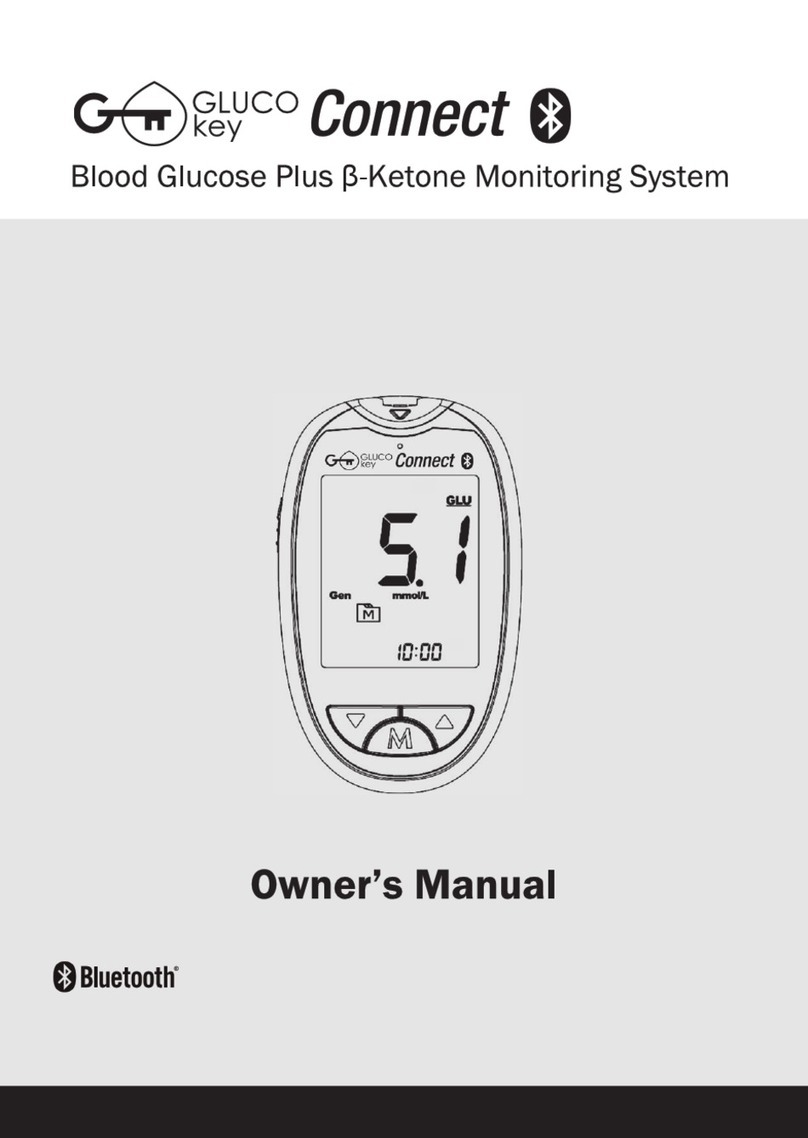
Nipro
Nipro GlucoKey Connect TD-4183D/GD82a owner's manual
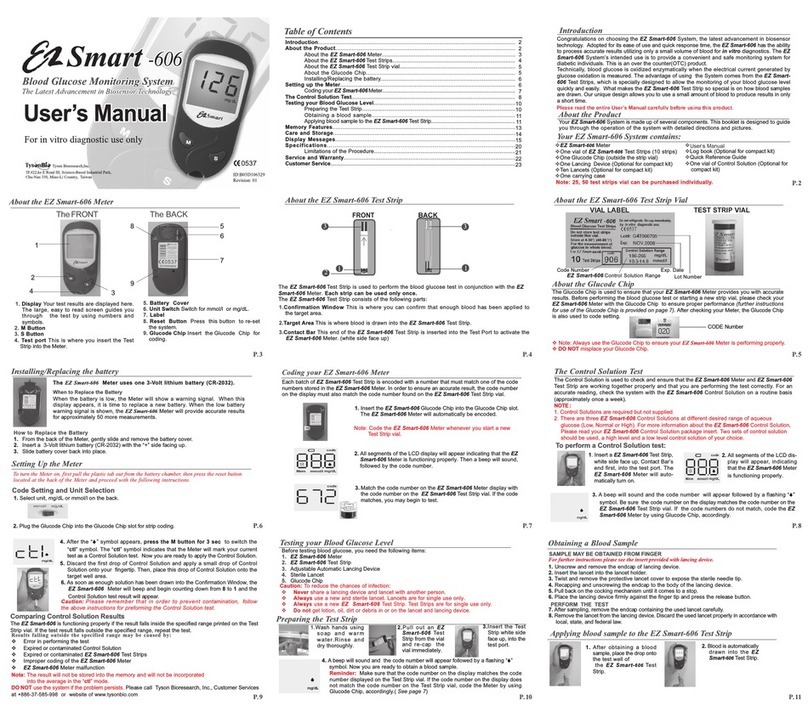
EZ Smart
EZ Smart 606 user manual
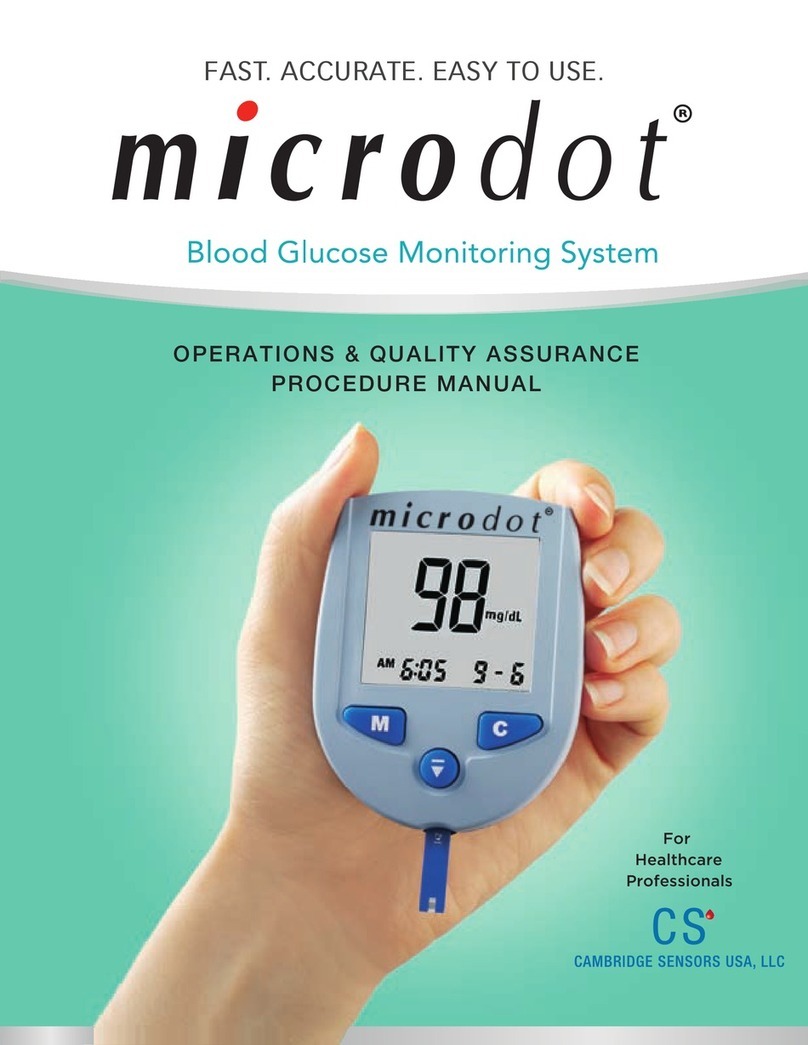
Cambridge Sensors
Cambridge Sensors microdot Operation manual

Abbott
Abbott FreeStyle Freedom Lite owner's booklet
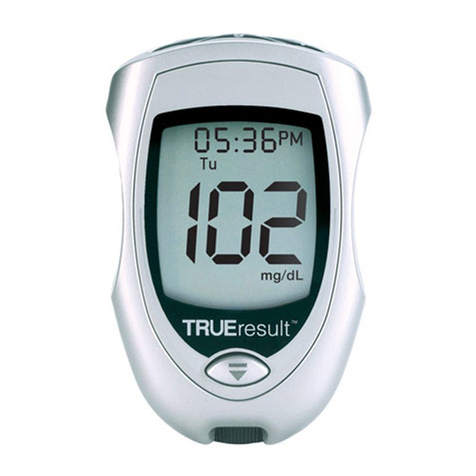
NIPRO Diagnostics
NIPRO Diagnostics TRUEresult owner's manual
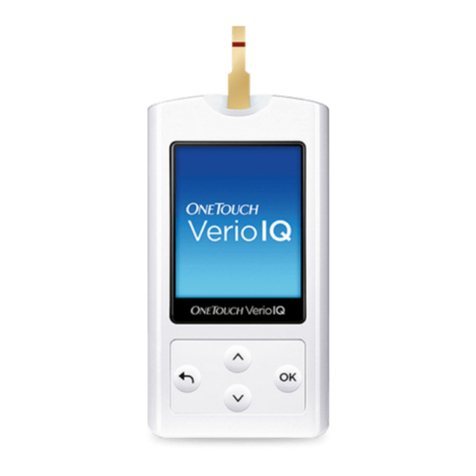
OneTouch
OneTouch Verio IQ owner's booklet
